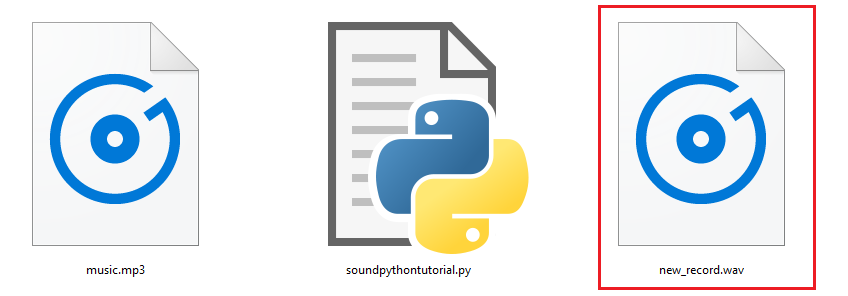There are many applications out there on the internet that can play and record audio files such as mp3, wav, and mp4. If you are a Python developer and wish to write code that can record or play audio for you, then continue reading this article.
In this Python tutorial, I will walk you through two Python programs that can play and record audio.
How to Play and Record Audio in Python?
Install Required Libraries
Before we can code in Python to play and record audio, we need to install three Python libraries, namely playsound, sounddevice, and Scipy.
1) Python
playsound
library
As the library name suggests, the
playsound
library is used to play different types of audio files. It is an open-source Python library, and you can install it using the following pip command:
pip install playsound
2) Python
sounddevice
library
The Python
sounddevice
library is another open-source library that is used to play and record NumPy arrays containing sound singles. This means it uses NumPy arrays to generate and structure audio file data. To install the
sounddevice
library, run the following pip command on your terminal or command prompt:
pip install sounddevice
3) Python Scipy library
Scipy
is a scientific computing library for Python, and in this tutorial, we will be using this library to save or write the data generated by the
sounddevice
library. Install the Python library using the following command:
install numpy scipy
Python Program to Play Audio Files
Playing an audio file is very straightforward with the Python
playsound
library. Check out the following code:
from playsound import playsound
filename = "music.mp3"
print(f"Playing {filename}..............................")
playsound(filename) #play audio
Output
Playing music.mp3..............................
In this example, the
music.mp3
audio file is located in the same directory where the Python script is, and that's why we have only specified the file name, not the complete path.
Thus, if your audio file is located in some directory other than the directory having the Python script, then you need to specify the full path, like:
filename =r"C:\Users\tsmehra\music\music.mp3"
How to Record Audio in Python?
Now you know how to play audio in Python using the Python
playsound
library. Next, let's write a Python program that will record audio from your mic. Let's start with importing the required modules.
import sounddevice as sd
from scipy.io.wavfile import write
from playsound import playsound
import time
With the
sounddevice
module, we will record the audio in the
wav
format. Using the
scipy.io.wavfile
write
module, we will save the recorded
wav
audio file locally, and the
playsound
module will allow us to play the recorded file. With the
time
module, we will create a recording timer.
Now, let's define a timer function that will print the timer while the audio is recording.
def timer(duration):
while duration:
mins, secs = divmod(duration, 60)
timer = f"{mins} mins:{secs} seconds Left"
print(timer, end=" \r")
time.sleep(1)
duration -= 1
Next, let's define the audio_record function that will record the audio and save it locally:
def record_audio(filename):
#frequency
fs=44100 #frames per second
duration = 10 # seconds in integer
print("Recording..........")
#start recording
myrecording = sd.rec(int(duration * fs), samplerate=fs, channels=2)
timer(duration) #call timer function
sd.wait()
#write the data in filename and save it
write(filename, fs, myrecording)
The
fs
variable specifies the frequency of the audio in frames per second, and its value could either be 44,100 or 48,000. The
duration
variable defines the recording duration in seconds.
rec()
initializes the recording object while the
wait()
function holds the recording screen for the specified
duration
. Also, the
write()
function writes the recorded data and saves it in the same directory where the Python script is located, with the specified
filename
.
Now, let's declare a variable that represents the recorded audio file name and calls the record_audio function.
filename ="new_record.wav"
record_audio(filename)
listen = input("Do you want to listen the recorded audio? [y/n]")
if listen.lower() =="y":
playsound(filename)
Finally, let's put all the code together and execute it.
#Python program to record an audio file.
import sounddevice as sd
from scipy.io.wavfile import write
from playsound import playsound
import time
def timer(duration):
while duration:
mins, secs = divmod(duration, 60)
timer = f"{mins} mins:{secs} seconds Left"
print(timer, end=" \r")
time.sleep(1)
duration -= 1
def record_audio(filename):
#frequency
fs=44100 #frames per second
duration = 10 # seconds in integer
print("Recording..........")
#start recording
myrecording = sd.rec(int(duration * fs), samplerate=fs, channels=2)
timer(duration) #call timer function
sd.wait()
#write the data in filename and save it
write(filename, fs, myrecording)
filename ="new_record.wav"
record_audio(filename)
listen = input("Do you want to listen the recorded audio? [y/n]")
if listen.lower() =="y":
playsound(filename)
Output
When you execute the program, look in the directory where your Python script is located. There you will find a new wav audio file with the name
new_record.wav
.

Conclusion
In this Python tutorial, you learned "
How to Play audio in Python?
" and "
How to Record Audio in Python?
" In this tutorial, we have used three Python libraries, which are
playsound
,
sounddevice
, and
Scipy
.
We would recommend you read the official documentation of these three libraries if you want to perform more audio-related functions in Python. Let us know in the comments if you come across any issues.
People are also reading:





Leave a Comment on this Post